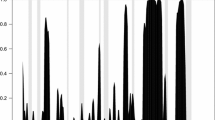Abstract
This paper characterizes rules-based fiscal policy setting for G-3 and large EMS countries. We set up a simple fiscal policy rule and then infer on the policymakers’ reaction coefficients by testing with GMM. Our results qualify existing evidence on systematic fiscal policy in two respects. First, fiscal policy usually stabilizes public debt; and there is indeed substantial interaction between fiscal and monetary policies via the policy mix or the debt channel. Second, sustainability is achieved with a “stop–go” cycle of consolidation. Unless debt ratios are high, consolidation does not come at the cost of less cyclical stabilization.
Similar content being viewed by others
References
Alesina A, Drazen A (1991) Why are stabilizations delayed? Am Econ Rev 81(5):1170–1187
Artis M, Buti M (2001) Close to balance or in surplus: a policy-maker’s guide of the implementation of the SGP. J Common Market Stud 34:563–592
Auerbach A (2002) Is there a role for discretionary fiscal policy? In: Rethinking stabilization policies. Federal Reserve Bank of Kansas City, pp 109–150
Ballabriga F, Martinez-Mongay C (2003) Has EMU shifted monetary and fiscal policies? In: Buti M (ed) Monetary and fiscal policies in EMU: interactions and coordination. Cambridge University Press, Cambridge
Benigno P, Woodford M (2003) Optimal monetary and fiscal policy: a linear-quadratic approach. NBER Working Paper No. 9905
Blanchard O, Simon J (2001) The long and large decline in US output volatility. Brookings Pap Econ Act 1:135–164
Bohn H (1998) The behavior of US public debt and deficits. Quart J Econ 113(3):949–963
Buiter W (1999) The fallacy of the fiscal theory of the price level. NBER Working Paper No. 7302
Buti M, Roeger H, In't Veld J, (2001) Monetary and fiscal policy interactions under a Stability Pact. J␣Common Market Stud 39:801–828
Cochrane J (1998) A frictionless view of US inflation. NBER Macroecon Ann 13:323–384
Fatas A, Mihov I (2001) Government size and automatic stabilizers: international and intranational evidence. J Int Econ 55:3–28
Fatas A, Mihov I (2003) On constraining fiscal policy discretion in EMU. Oxford Rev Econ Policy 19(1):112–131
Favero C (2002) How do European monetary and fiscal authorities behave? CEPR Discussion Paper No. 3426
Fuhrer J, Rudebusch G (2002) Estimating the Euler equation for output. Federal Reserve Bank of Boston, Working Paper No. 3
Galí J, Perotti R (2003) Fiscal policy and monetary integration in Europe. Econ Policy 37:535–572
Galí J, Gertler M, Lopez-Salido J (2001) European inflation dynamics. Eur Econ Rev 45:1237–1270
Hochreiter E, Winckler G (1995) The advantages of tying Austria’s hands: the success of the hard currency strategy. Eur J Pol Econ 11(1):83–111
Lane P (2003) The cyclical behavior of fiscal policy: evidence from the OECD. J Public Econ 87(12):2661–2675
Mélitz J (2000) Some cross-country evidence about fiscal policy behavior and consequences for EMU. Eur Econ 2:3–21
Staiger D, Stock J (1997) Instrumental variables regression with weak instruments. Econometrica 65(3):557–586
Taylor J (2000) Reassessing discretionary fiscal policy. J Econ Perspect 14(3):21–36
Van den Noord P (2002) Automatic stabilizers in the 1990s and beyond. In: Buti M, Von Hagen J, Martinez-Mongay C (eds) The behavior of fiscal authorities: stabilization, growth and institutions. Palgrave, London, pp 130–148
Von Hagen J (1999) A new approach to monetary policy (1971–8). In: Bundesbank Deutsche (ed) Fifty years of the Deutsche Mark. Beck, Munich, pp 404–438
Woodford M (2001) Fiscal requirements for price stability. J Credit Money Bank 33:669–728
Acknowledgements
This paper is based on my doctoral research on “Fiscal and Monetary Policy Interaction: an empirical analysis”. I would like to thank three anonymous referees, and my supervisors Anindya Banerjee and Michael Artis for helpful suggestions. Further comments by Florin Bilbiie, Andrew Hughes Hallett, Alessandro Missale, Albrecht Ritschl and by participants at the CESifo conference on “Sustainability of Public Debt” also provided many insights. Any remaining errors are mine. Research is supported by the “Campilli-Formentini” grant of the European Investment Bank.
Author information
Authors and Affiliations
Corresponding author
Rights and permissions
About this article
Cite this article
Claeys, P. Policy mix and debt sustainability: evidence from fiscal policy rules. Empirica 33, 89–112 (2006). https://doi.org/10.1007/s10663-006-9009-9
Published:
Issue Date:
DOI: https://doi.org/10.1007/s10663-006-9009-9




